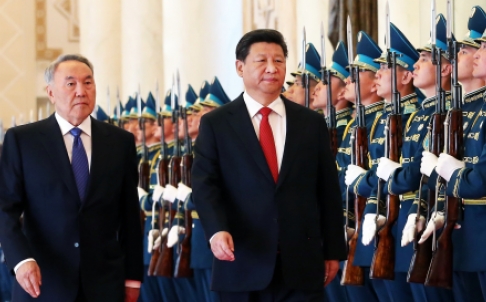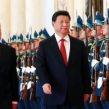
“One Belt, One Road” Enhances Xi Jinping’s Control Over the Economy
Publication: China Brief Volume: 15 Issue: 10
By:

Much of the world’s interest in China’s “One Belt, One Road” (OBOR) strategy—a reference to the Silk Road Economic Belt (SREB) and the 21st Century Maritime Silk Road (MSR)—is focused on the geopolitical implications of one of the most ambitious initiatives of Chinese President Xi Jinping. Yet OBOR also has immense significance for the future direction of the economy, especially the partial revival of central planning as well as boosting the pivotal role of state-owned enterprise (SOE) conglomerates. Moreover, the intercontinental megaproject testifies to major shifts in Chinese elite politics. Power has further been concentrated in the hands of Chinese Communist Party (CCP) General Secretary Xi, as well as his cronies and advisors in the Party-state apparatus. Furthermore, Premier Li Keqiang and his relatively liberal ministers in the State Council, or central government, have been increasingly sidelined.
While the SREB and the MSR will substantiate China’s global hard-power projection, the infrastructure-based scheme also fits hand-in-glove with President Xi’s insistence on the “top-level design” of economic development. Xi has reiterated that the CCP has to have a tight grip over the economy if it is to remain the country’s “perennial ruling party.” What officials euphemistically call the “macro-economic adjustment and control” of the economy has been enhanced since Xi took power at the 18th Party Congress in November 2012. Despite the removal of tens of high-level SOE managers for corruption and economic crimes, Xi has in Party documents and public speeches reiterated that Beijing must “incessantly strengthen the vitality, control and influence of the state-owned economy” (Xinhua, December 2, 2014; People’s Daily, November 16, 2013). The OBOR is an economic planner’s delight. While negotiations are on-going with Central Asia and the Caucus states concerning the trajectory of the SREB—and with countries ranging from Indonesia and Malaysia to Pakistan and the Maldives regarding the MSR—Beijing is also mapping out strategies for OBOR-related ventures to be undertaken by at least 18 provinces and dozens of SOE giants (Sl.China.com.cn [Beijing], March 14; Finance.Eastmoney.com [Shanghai], May 29, 2014).
The OBOR megaproject, which the official Chinese media estimates will initially contribute at least 0.25 percent of China’s GDP growth, has provided highly lucrative business opportunities for ten-odd infrastructure-focused state-controlled firms (Beijing Morning Post, March 25). One example is the China State Construction Engineering Corporation Limited (CSCEC), a multinational real-estate and civil-engineering conglomerate, which has in the past three decades completed close to 6,000 projects in 116 countries (Finance Sector Net [Beijing], May 4; CSCEC website). Another beneficiary, the mammoth China Communications Construction Company Limited (CCCCL), has ample experience building bridges, highways, commercial ports and container ports on four continents. Also hitting the big time is China CAMC Engineering Co., Ltd. (CAMCE), one of the world’s largest engineering and construction contractors. It has worked with governments and major firms in Russia, Africa and Eastern Europe, among other places (Economic Daily [Beijing], May 6; Finance Sector Net, April 7). The stock prices of these and other corporations in the construction and engineering sector have risen dramatically since the spring (Southmoney.com [Xiamen], April 16; Ta Kung Pao [Hong Kong], March 24).
The SANY Group stands out among private firms that will benefit from massive OBOB-related infrastructure deals (CS.com.cn [Beijing], April 23; Eastmoney.com [Shanghai], December 26, 2014). SANY, founded by charismatic multi-millionaire Liang Wen’gen, is China’s biggest manufacturer of construction and heavy-engineering equipment. This high-profile multinational, which is well-known for its innovative capacity, has close connections to the CCP. Liang, a faithful Party member, was touted as a candidate for the Central Committee in the run-up to the 18th CCP Congress. While he failed to make the ruling council, Liang’s intimate ties to the Party elite are strong (BBC Chinese Service, October 3, 2012; Rednet [Changsha] August 24, 2012). Two private telecommunication giants are also tipped to win big contracts along the New Silk Road. They include Huawei—the largest information technology (IT) equipment maker in the world—and ZTE, which are multinationals with sterling connections to the Party-state apparatus (Ta Kung Pao, April 4; Shanghai Securities News, February 12).
The OBOR has also enabled Beijing to enforce more effective control over its domestic regions. So far, some 20 provinces and major cities have won central approval for “official participation” in the international scheme. Given that provincial-level companies will have to apply for loans administered by the Party-state headquarters—for example, the recently established Silk Road Infrastructure Fund that is worth $40 billion—the Xi administration has an effective weapon to rein in centrifugal forces (Financial Times, April 15; South China Morning Post [Hong Kong], February 17; 21st Century Business Herald (Guangzhou), May 29, 2014). At the same time, Chinese companies’ likely success in nailing down construction, engineering and transportation deals along both silk roads should allow Beijing to curtail excess capacity in sectors ranging from housing construction to high-speed railways. Despite the global reputation of China’s high-speed trains, the state-owned China North Railways Corporation and China South Railways Corporation Limited—which have monopolistic control over railway development and are about to merge—have piled up debts of around 3 trillion Renminbi ($484 billion). The two giants, which enjoy hefty subsidies from the central treasury, are expected to win contracts in new markets in Central Asia, East Europe and Africa thanks to the roll-out of the OBOR mega-scheme (China.com.cn, April 1; New York Times, September 23, 2013).
The Xi administration’s re-emphasis on the time-tested method of using investment—and state planning—to maintain a relatively high GDP growth rate was evidenced by a Politburo meeting on April 30 that was devoted to the economy. The session, which was chaired by President Xi, noted that government stimulus must be increased to guard against serious “downward trends” in economic development. A statement released after the high-level conclave reaffirmed that the government “must develop the critical role of investment in [boosting] the economy and seriously make sure that good investment projects are chosen.” Commentaries in the official media noted a “change of focus from economic restructuring to growth stabilization.” They added that “the top choice for stabilizing the economy will be boosting investment” (People’s Daily, May 3; South China Morning Post [Hong Kong], May 1).
In an apparent attempt to defuse speculation that the Politburo is putting market-oriented reforms on the backburner, the meeting highlighted the principle of the so-called “three no changes.” This was a reference to the fact that Beijing would not shift its policy in three key arenas: reforming SOEs, protecting the assets and interests of private enterprises and upholding the open-door policy, particularly welcoming foreign capital. However, the Party-state leadership has dragged its feet regarding promises made at the historic Central Committee’s Third Plenum in late 2013 about providing more opportunities for private and foreign enterprises. For example, only four Free Trade Zones—in relatively small conclaves in Shanghai, Tianjin, Guangdong and Fujian—have been opened where multinationals are supposed to have access to sectors previously reserved for Chinese firms (Xinhua, April 20; The Diplomat, September 20, 2014). By contrast, regional administrators are much more eager to seek Beijing’s blessings for taking part in projects related to the New Silk Road.
Yet, the best illustration of the Xi leadership’s embrace of a more conservative economic policy is the sidelining of Premier Li Keqiang. Li, the only fluent English speaker in the Politburo, is a keen advocate of market-oriented reforms. The gist of “Likonomics”—a term that appeared for only several months in the official media in 2013—is “letting the market do what it does best” (Gov.cn, July 15, 2014; Finance.qq.com [Beijing], November 28, 2013). Li’s sway over policy-making, however, is circumscribed due to the fact that he has to defer to supreme leader Xi. Xi, the Fifth-Generation titan, chairs the two most powerful economy-related organs at the apex of the party: the long-established Central Leading Group on Finance and Economics (CLGFE) and the Central Leading Group on Comprehensively Deepening Reforms (CLGCDR), which was set up two years ago. Previous premiers, including Zhu Rongji and Wen Jiabao, used to head the CLFGE—and had ultimate responsibility for economic matters (see China Brief, July 3, 2014).
The OBOR initiative has also confirmed that the seventh-ranked member of the Politburo Standing Committee, Executive Vice-Premier Zhang Gaoli, wields more powers than his putative boss Premier Li. Zhang chairs the recently established Central Leading Group on the Construction of the One Belt One Road (CLGOBOR) (Xinhua, April 6; Securities News [Beijing], February 2). And regarding the division of labor within the central government cabinet, Zhang is in charge of heavyweight ministerial-units, including the National Development and Reform Commission and the Ministry of Finance (Ming Pao [Hong Kong], April 24; China.com.cn, March 22).
Xi has mainly relied on a number of faithful aides and think tank specialists to advise him on different aspects of the economy. Most of them hold senior positions in leading groups at the top echelon of the CCP hierarchy. Highest ranked among this elite is Politburo member and Director of the Central Committee Policy Research Office Wang Huning, who doubles as the Director of the General Office of the CLGCDR as well as Vice-Chairman of the CLGOBOR. While Wang (born 1955) is not an economist by training, he has been a leading advisor to three general secretaries, particularly on grand strategies (Southern Metropolitan Weekly [Guangzhou], November 26, 2013; Inewsweek.cn [Beijing], June 27, 2013).
Xi also relies heavily on senior staff of the General Office of the CLGFE, sometimes deemed the nerve center of national economic decision-making. Director Liu He (born 1952), a Harvard-trained economist who first came to know Xi when they both attended the 101 High School in Beijing, often accompanies Xi during provincial tours. Vice-Director Shu Guozeng (born 1956), was deputy director-general of the General Office of the Zhejiang CCP Committee when Xi served as the Party Secretary of the coastal province from 2002 to 2007 (China Securities Net [Beijing], December 3, 2014; People’s Daily, December 3, 2014). Other experts who are advisors of Xi include former chief economist of the World Bank Justin Lin, Vice-Directors of the Chinese Academy of Social Sciences (CASS) Cai Fang and Li Yang, and President of the Shanghai Branch of CASS Wang Zhan (Phoenix TV, July 9, 2014; First Financial News [Shanghai] August 29, 2014).
At least in theory, the fact that Xi is using his authority as China’s undisputed strongman to push megaprojects such as OBOR could speed up decision-making and curtail bureaucratic delays on the part of local administrations or SOE conglomerates. The Party and state leader’s preference for top-level design and tight Party control over economic activities, however, could stifle initiatives coming from the private sector, which is considered more efficient and high technology–driven than the state-owned economy. More significantly, Party-state authorities have for the past decade tried to restructure the economy by playing down the role of state investment in infrastructure and related sectors—and putting more emphasis on areas ranging from consumer spending to innovative industries and services. The Xi leadership’s apparent obsession with Soviet-style megaprojects does not seem to bode well for the long-term prospects of economic reform and restructuring.





